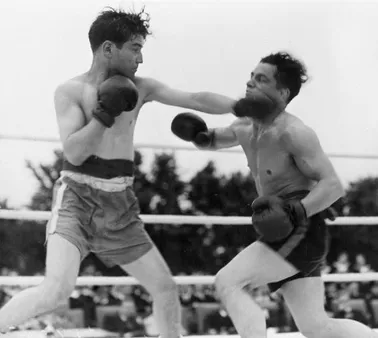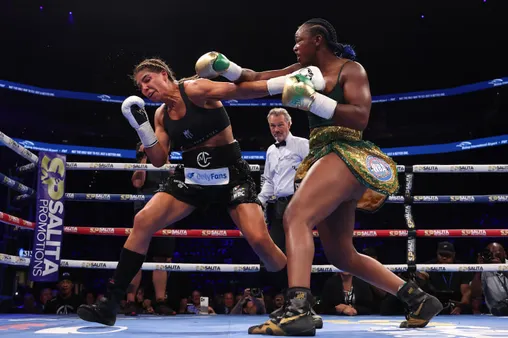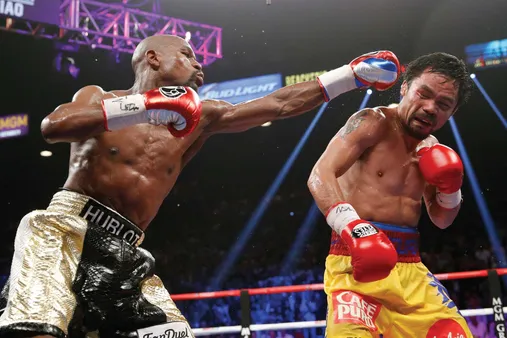Table of Contents
Welcome to the captivating world of Boxing at Kizworld, where strength, agility, and strategy collide in a dance of athleticism and determination. Throughout history, boxing has enthralled audiences with its raw power and unwavering spirit. From ancient gladiatorial contests to modern-day championship bouts, boxing has captivated hearts and tested the limits of human endurance. Whether you're an aspiring fighter seeking guidance or an enthusiast eager to delve deeper into the sport, kizworld invites you on a journey through the fascinating realm of boxing. Discover the rich history, diverse disciplines, and transformative benefits that await you within the squared circle.
Journey into Boxing: Unleashing Your Inner Strength and Grit
I. A Brief History of Boxing
The history of boxing can be traced back to ancient Greece, Rome, and Egypt, where it was practiced as a sport and a form of combat training. In the 18th and 19th centuries, boxing evolved into a more formalized sport with rules and regulations, thanks to the contributions of influential figures like Jack Broughton and the Marquess of Queensberry. Throughout the 20th century, boxing gained immense popularity and produced legendary champions such as Muhammad Ali, Sugar Ray Robinson, and Mike Tyson. Today, boxing remains a popular sport, with major organizations like the World Boxing Council (WBC), World Boxing Association (WBA), and International Boxing Federation (IBF) sanctioning professional fights and crowning world champions.
Ancient Origins of Boxing
- Boxing was practiced in ancient Greece, Rome, and Egypt as a sport and a form of combat training.
- In ancient Greece, boxing was part of the Olympic Games, and victors were highly celebrated.
- Roman gladiators often engaged in boxing matches as part of their training and entertainment.
The Rise of Modern Boxing
- In the 18th century, Jack Broughton introduced rules and regulations to boxing, including the use of gloves and rounds.
- The Marquess of Queensberry rules, established in 1865, further standardized boxing and laid the foundation for modern boxing.
- The late 19th and early 20th centuries saw the emergence of great boxers like John L. Sullivan and Jack Dempsey, who helped popularize the sport.
The Golden Age of Boxing
The 1950s and 1960s are considered the golden age of boxing, with iconic fighters like Muhammad Ali, Sugar Ray Robinson, and Joe Louis capturing the world's attention.
Muhammad Ali, in particular, transcended the sport and became a global icon for his athleticism, social activism, and outspoken personality.
Muhammad Ali | "The Greatest" |
Sugar Ray Robinson | "Sugar" |
Joe Louis | "The Brown Bomber" |
Jack Dempsey | "The Manassa Mauler" |
Rocky Marciano | "The Brockton Blockbuster" |
Modern Boxing and Its Evolution
- In the late 20th and early 21st centuries, boxing continued to evolve, with the emergence of new weight classes and international competitions.
- The sport has faced challenges related to safety, doping, and financial controversies, leading to reforms and increased oversight.
- Despite these challenges, boxing remains a popular sport, with millions of fans worldwide following the exploits of contemporary champions like Manny Pacquiao, Floyd Mayweather Jr., and Saul "Canelo" Alvarez.
Conclusion: The Enduring Legacy of Boxing
Boxing has stood the test of time, capturing the imagination of audiences for centuries. From its ancient origins to its modern iterations, the sport has produced legends, rivalries, and iconic moments that have left an indelible mark on sports history.
While boxing has faced controversies and challenges along the way, it continues to endure as a testament to the human spirit, the pursuit of excellence, and the thrill of competition.
II. Various Types of Boxing
Various Types of Boxing
From the sweet science of pugilism to the brutal art of bare-knuckle brawling, boxing has evolved into a diverse and multifaceted sport encompassing a wide range of styles and techniques. Whether you're a fan of the fast-paced exchanges of professional boxing or the raw power and aggression of street fighting, there's a type of boxing out there to suit every taste.
Below, we'll take a closer look at some of the most popular types of boxing, exploring their unique characteristics, rules, and training methods.
Professional Boxing
Professional boxing is the most well-known and widely recognized form of the sport. Governed by strict rules and regulations, professional boxing matches are typically held in a boxing ring between two trained and experienced fighters. Boxers wear protective gloves and compete in scheduled rounds, with the aim of knocking out their opponent or winning a decision by points.
Types of Professional Boxing:
- Lightweight Boxing: Emphasizes speed and agility.
- Middleweight Boxing: Focuses on power and endurance.
- Heavyweight Boxing: Prioritizes size and strength.
Amateur Boxing
Amateur boxing shares many similarities with professional boxing, but with a few key differences. Amateur boxers typically wear headgear and compete in shorter rounds. The focus is more on skill development and sportsmanship than on winning or losing.
Types of Amateur Boxing:
- Olympic Boxing: The most prestigious amateur boxing competition.
- National Championships: Held in various countries to determine the best amateur boxers.
- Golden Gloves: A popular amateur boxing tournament held in the United States.
Street Fighting
Street fighting is a raw and unregulated form of boxing that takes place outside of the ring. Street fights can be spontaneous or arranged, and they often involve untrained fighters. While street fighting is often associated with violence and danger, it can also be a test of skill, courage, and resilience.
Types of Street Fighting:
- Bare-Knuckle Boxing: A type of street fighting where boxers do not wear gloves.
- MMA Street Fighting: Combines boxing with other martial arts techniques, such as grappling and kicking.
- No-Holds-Barred Fighting: A chaotic and unpredictable form of street fighting with no rules or restrictions.
Other Types of Boxing
In addition to the three main types of boxing listed above, there are also a number of other variations of the sport, including:
- Kickboxing: Integrates elements of boxing with kicking techniques.
- Martial Arts
- Muay Thai: Also known as Thai boxing, combines punching, kicking, elbows, and knees.
- How to Choose the Right Martial Art for You
- Savate: A French form of boxing that allows for kicking below the waist.
No matter which type of boxing you choose to pursue, it's important to remember that boxing is a physically and mentally demanding sport. It requires dedication, discipline, and a willingness to push yourself to your limits.
III. Boxing Techniques and Strategies
Boxing Techniques and Strategies 
Footwork and Movement
Footwork is essential in boxing, as it allows boxers to move around the ring quickly and efficiently. Boxers use a variety of footwork techniques to create angles, avoid punches, and set up their own attacks. Some common footwork techniques include the jab step, the cross step, and the pivot.
- The jab step is a quick step forward with the lead foot, followed by a quick step back with the rear foot. This technique is used to create distance and set up a jab.
- The cross step is a step forward with the rear foot, followed by a step forward with the lead foot. This technique is used to close the distance and set up a cross.
- The pivot is a turn on the ball of the lead foot, followed by a step in the desired direction. This technique is used to change direction quickly and avoid punches.
Boxers also use a variety of movement techniques to create angles and avoid punches. Some common movement techniques include the slip, the duck, and the weave.
- The slip is a quick movement of the head to the side to avoid a punch.
- The duck is a quick movement of the head down to avoid a punch.
- The weave is a series of quick head movements to avoid punches.
Footwork and movement are essential skills for boxers, as they allow them to control the ring and avoid getting hit.
Punching Techniques
Boxing is a sport of punching, and there are a variety of different punches that boxers can use. The most common punches are the jab, the cross, the hook, and the uppercut.
- The jab is a quick, straight punch thrown with the lead hand. The jab is used to create distance, set up other punches, and score points.
- The cross is a powerful, straight punch thrown with the rear hand. The cross is used to knock out opponents and score points.
- The hook is a short, looping punch thrown with the lead hand. The hook is used to attack the body and head.
- The uppercut is a short, upward punch thrown with the rear hand. The uppercut is used to attack the chin and score knockouts.
Boxers use a variety of combinations of punches to attack their opponents. Some common combinations include the jab-cross, the jab-hook, and the cross-hook-uppercut.
Punching techniques are essential for boxers, as they allow them to score points, knock out opponents, and win fights.
Defensive Techniques
Boxing is a sport of punching, but it is also a sport of defense. Boxers use a variety of defensive techniques to avoid getting hit. Some common defensive techniques include the block, the parry, and the dodge.
- The block is a movement of the arms or body to stop a punch.
- The parry is a movement of the hand or arm to deflect a punch.
- The dodge is a movement of the head or body to avoid a punch.
Boxers also use a variety of head movement techniques to avoid punches. Some common head movement techniques include the slip, the duck, and the weave.
- The slip is a quick movement of the head to the side to avoid a punch.
- The duck is a quick movement of the head down to avoid a punch.
- The weave is a series of quick head movements to avoid punches.
Defensive techniques are essential for boxers, as they allow them to avoid getting hit and stay in the fight.
IV. Boxing's Impact and Legacy
Boxing's Impact and Legacy
The impact of boxing extends far beyond the ring. It has shaped cultures, influenced politics, and inspired countless individuals. Whether it's the legendary bouts of Muhammad Ali or the inspiring story of Rocky Balboa, boxing has left an indelible legacy that continues to inspire and captivate generations.
One of the most significant impacts of boxing is its ability to transcend cultural and societal boundaries. Boxers from all corners of the world have graced the リング, uniting people from diverse backgrounds in a shared passion for the sport. The Olympic Games, with its global reach, has played a pivotal role in showcasing the universal appeal of boxing, fostering camaraderie and understanding among athletes from different nations.
- Boxing has also served as a powerful tool for social and political change.
- The sport has been instrumental in breaking down racial barriers, challenging societal norms, and promoting equality.
- Boxers like Jack Johnson and Joe Louis used their platform to fight against discrimination and injustice, inspiring countless individuals to stand up for their rights.
Legendary Boxer | Impact and Legacy |
|---|---|
Muhammad Ali | Known for his poetic words and exceptional skills, he transcended the sport and became a global icon, inspiring millions with his message of peace and equality. |
Sugar Ray Robinson | Often regarded as the greatest pound-for-pound boxer of all time, Robinson's incredible speed and agility revolutionized the sport and set a new standard for technical excellence. |
Joe Louis | A symbol of American pride during World War II, Louis's victories in the ring boosted morale and helped rally the nation against injustice and discrimination. |
Moreover, the inspirational stories of boxers have been immortalized in literature, film, and popular culture, further solidifying the sport's place in society. From the rags-to-riches tale of Rocky Balboa to the triumphant comeback of Muhammad Ali, these narratives have captured the imagination of millions, showcasing the resilience, determination, and triumph of the human spirit.
In conclusion, boxing's impact and legacy extend far beyond the boundaries of the ring. The sport has inspired generations, broken down barriers, and played a significant role in shaping culture and society. With its captivating stories of triumph and resilience, boxing continues to captivate audiences worldwide.
V. Conclusion
As the final bell rings, we come to the end of our exploration into the world of boxing. From its storied history and diverse variations to the physical and mental benefits it offers, boxing has proven to be a captivating sport that demands respect and admiration. Whether you choose to step into the ring or remain a passionate spectator, boxing's legacy will continue to inspire and captivate generations to come. The future of boxing looks bright, with new stars emerging and the sport gaining popularity worldwide. As boxing continues to evolve, one thing is certain: its ability to ignite passion, test limits, and create unforgettable moments will endure for years to come.